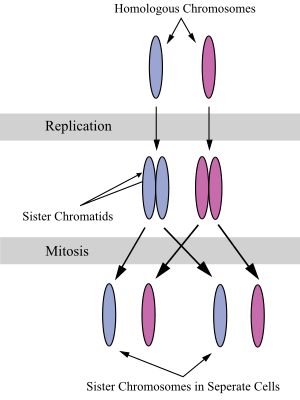

A sister chromatid refers to the identical copies (chromatids) formed by the DNA replication of a chromosome, with both copies joined together by a common centromere. In other words, a sister chromatid may also be said to be 'one-half' of the duplicated chromosome. A pair of sister chromatids is called a dyad. A full set of sister chromatids is created during the synthesis (S) phase of interphase, when all the chromosomes in a cell are replicated. The two sister chromatids are separated from each other into two different cells during mitosis or during the second division of meiosis.
Compare sister chromatids to homologous chromosomes, which are the two different copies of a chromosome that diploid organisms (like humans) inherit, one from each parent. Sister chromatids are by and large identical (since they carry the same alleles, also called variants or versions, of genes) because they derive from one original chromosome. An exception is towards the end of meiosis, after crossing over has occurred, because sections of each sister chromatid may have been exchanged with corresponding sections of the homologous chromatids with which they are paired during meiosis. Homologous chromosomes might or might not be the same as each other because they derive from different parents.
There is evidence that, in some species, sister chromatids are the preferred template for DNA repair.[1] Sister chromatid cohesion is essential for the correct distribution of genetic information between daughter cells and the repair of damaged chromosomes. Defects in this process may lead to aneuploidy and cancer, especially when checkpoints fail to detect DNA damage or when incorrectly attached mitotic spindles do not function properly.
YouTube Encyclopedic
-
1/3Views:47 0141 369 04267 128
-
Homologous Chromosomes vs Sister Chromatids Explained!
-
Chromosome Numbers During Division: Demystified!
-
Chromosomes, chromatin, chromatid and sister chromatid
Transcription
Mitosis

Mitotic recombination is primarily a result of DNA repair processes responding to spontaneous or induced damages.[2][3][4] Homologous recombinational repair during mitosis is largely limited to interaction between nearby sister chromatids that are present in a cell subsequent to DNA replication but prior to cell division. Due to the special nearby relationship they share, sister chromatids are not only preferred over distant homologous chromatids as substrates for recominational repair, but have the capacity to repair more DNA damage than do homologs.[1]
Meiosis
Studies with the budding yeast Saccharomyces cerevisiae[5] indicate that inter-sister recombination occurs frequently during meiosis, and up to one-third of all recombination events occur between sister chromatids.[citation needed]
See also
References
- ^ a b Kadyk, Lc; Hartwell, Lh (Oct 1992). "Sister chromatids are preferred over homologs as substrates for recombinational repair in Saccharomyces cerevisiae" (Free full text). Genetics. 132 (2): 387–402. doi:10.1093/genetics/132.2.387. ISSN 0016-6731. PMC 1205144. PMID 1427035.
- ^ Moynahan ME, Jasin M (2010). "Mitotic homologous recombination maintains genomic stability and suppresses tumorigenesis". Nat. Rev. Mol. Cell Biol. 11 (3): 196–207. doi:10.1038/nrm2851. PMC 3261768. PMID 20177395.
- ^ Symington LS, Rothstein R, Lisby M (2014). "Mechanisms and regulation of mitotic recombination in Saccharomyces cerevisiae". Genetics. 198 (3): 795–835. doi:10.1534/genetics.114.166140. PMC 4224172. PMID 25381364.
- ^ Luisa, Bozzano G. (2012-12-02). Aging, Sex, and DNA Repair. Academic Press. ISBN 978-0-323-13877-2.
- ^ Goldfarb T, Lichten M (2010). "Frequent and efficient use of the sister chromatid for DNA double-strand break repair during budding yeast meiosis". PLOS Biol. 8 (10): e1000520. doi:10.1371/journal.pbio.1000520. PMC 2957403. PMID 20976044.
